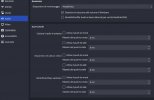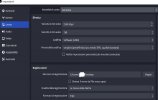Just FYI, from the pro audio side of things:
XLR is:
Pin 1 - X - Shield / Ground
Pin 2 - L - Live / Hot
Pin 3 - R - Return / Cold
TRS is:
Tip - Hot / Live
Ring - Cold / Return
Sleeve - Ground / Shield
Same signals, different plugs, handled the same way, hence the combo jack. It's also valid to use a separate jack for each type, like on an analog mixing console. That's cheaper than a combo, and might be what you're used to, but when space is tight and only one is valid at a time anyway, the combo works well.
TS has a longer sleeve, effectively just removing the insulation between Ring and Sleeve. Thus, a TS plug keeps Cold grounded, so that the unbalanced Hot still has something to refer to. That's usually how a guitar cord works, at the receiving end.
TRS IS NOT STEREO!!! Nor is it anything else. It's just a 3-pin connector that can have anything on it. Some common incompatible standards are:
Balanced mono, as above:
Tip - Hot / Live
Ring - Cold / Return
Sleeve - Ground / Shield
Unbalanced stereo:
Tip - Left
Ring - Right
Sleeve - Ground
Ground can't be an effective shield here, because it's now the reference for both signals. Anything that it picks up will appear on the signals, again because it's the *reference* for those signals.
Unbalanced mono insert:
Tip - Send
Ring - Return
Sleeve - Ground
This is used on analog mixing consoles, to take a signal out of the board, through some external processing, and put it back into the board at the same point that it came out. Effectively *inserting* the outboard processing at that point in the board's internal chain. It has a switch built into the jack, so when there's nothing plugged into it, it connects the Send and Return together, so the internal chain "just works" on it's own.
If you get the standards mixed up, because they do all use the exact same connectors, you WILL be confused! They've been common forever, mostly for lack of anything else, but if you use them, you really need to know what you're doing, as the original designers intended you to know.
Unbalanced stereo (like a phone or computer) feeding a balanced mono input (like a mixing console or a pro-level USB interface), will result in the center channel dropping out. You're actually listening to the *difference* of the two speakers instead of their sum, or the Side channel of Mid+Side encoding. Lead vocals, bass, and whatever else is panned center, will go away, and you're left with a mix of everything else that depends on how hard the mixing engineer panned each one. (how far off to either side it is)
To fix this, use two input channels, not just one, and use a cord that splits the stereo signal into two mono's. Likely a TRS on one end and two TS's on the other: one TS connects its Tip to the Tip of the TRS; the other to the Ring of the TRS. That same cord may also be used for Inserts, and sold as such, with the TRS going in the board, one TS going to an Input jack of the outboard gear, and the other TS to an Output jack.
Unbalanced stereo (same as above) feeding an unbalanced insert, will result in only the Right channel getting in, without an input gain control because the Insert point comes after that (and often after the EQ too, in an analog mixing desk, but not always), and the Left channel fighting the board's output driver for what signal should be on that wire. You probably won't notice that fight, until you use one or the other device for something else and wonder why that part of it doesn't work anymore. (the fight fried it) And you don't get Mono either, only Right, even though it splits from there into both speakers. That's still only the Right channel of what the mixing engineer intended.
This is often the next thing people try after the previous one sounds weird or "broken", but it's the one that could *actually* break something despite sounding mostly as expected.
DON'T EVER DO THIS!!! If you have the previous problem, use that solution. Only if you've recorded something from the Insert Sends, are you safe to play it back unchanged to the Insert Returns. For example, a multitrack recorder in the Insert loops of a console.
Unbalanced mono in an Insert jack, depends on which direction you're going:
If you're taking a signal *from* the board, that works, and the grounded Ring will make the rest of the channel strip "dead". Some people leave the plug half-out so the built-in switch doesn't activate, but that's just inviting someone else to push it in for you while you're gone because "it was about to fall out", and leave you wondering why that channel suddenly stopped working.
If you really *must* do this, make your own "Insert splitter" from a bare TRS jack that you connect Tip and Ring together, and also bring that out to the wire. Push that all the way in, and the channel strip will still work because of the Tip-Ring connection, and you also get that signal out to do something else with. For example, you might put it into to the Ring of a different channel Insert, to double-patch that mic: this gets you separate controls after the Insert point, like mute, fader, and routing, and whatever else that means for your board, only sharing the controls before that point, like the input gain.
If you're putting a signal *into* the board, then you have the same fight as the unbalanced stereo Left channel above. DON'T DO THAT!!!
Balanced mono feeding Unbalanced stereo, likely for recording on cheap gear, will appear to work just fine in headphones, might be weird in live speakers, and will drop out completely when the stereo track is mixed electronically to mono. Or it could only end up in the Left channel, while the Right channel is silent. Or it could "wander" between Left and Right channels, with the live-speaker weirdness and electronic-mix dropout becoming worst when the wander happens to be centered between Left and Right. Which you get, depends on how the balanced output works. A balanced receiver won't care: it just takes the difference between Hot and Cold and passes that on, which is a massive clue towards understanding why the weirdness and dropouts when you preserve both.
To fix this, use balanced receivers.
If you already have a recording that does this, you can try to fix it by inverting the Right channel and *then* mixing to mono. This is a poor simulation of a balanced receiver, but it might be good enough to work.
Again, if you're going to use 'phone plugs - TS or TRS, regardless of size because adapters also exist - you really need to know what each one is doing and don't mix them up. Just because they fit together does NOT mean they work together.
This is especially true if you have an amplifier with TS outputs! If you do the math for some of them, it gets pretty close to an American wall socket! (120V RMS: just because it's an audio signal does NOT mean it's safe!) And you just casually have that exposed at the other end of an unmarked 'phone cord when it's not plugged into a speaker!
Not to mention using a thin-wire guitar cord for the amount of power that it takes to drive that speaker. Also not good. Big-wire speaker cords also exist, with the same connector, and those technically work, but then you REALLY need to keep straight which is what! (and they still have an electrical shock hazard)
Before Speakon connectors (made specifically for speakers, and touch-safe in both genders), some people used wall-socket connectors, which had the advantage of using plain old extension cords to go as far as they needed, and the hazard of plugging one into an actual power outlet. Speakon was (and still is) a welcome relief. USE IT!!!
XLR is:
Pin 1 - X - Shield / Ground
Pin 2 - L - Live / Hot
Pin 3 - R - Return / Cold
TRS is:
Tip - Hot / Live
Ring - Cold / Return
Sleeve - Ground / Shield
Same signals, different plugs, handled the same way, hence the combo jack. It's also valid to use a separate jack for each type, like on an analog mixing console. That's cheaper than a combo, and might be what you're used to, but when space is tight and only one is valid at a time anyway, the combo works well.
TS has a longer sleeve, effectively just removing the insulation between Ring and Sleeve. Thus, a TS plug keeps Cold grounded, so that the unbalanced Hot still has something to refer to. That's usually how a guitar cord works, at the receiving end.
TRS IS NOT STEREO!!! Nor is it anything else. It's just a 3-pin connector that can have anything on it. Some common incompatible standards are:
Balanced mono, as above:
Tip - Hot / Live
Ring - Cold / Return
Sleeve - Ground / Shield
Unbalanced stereo:
Tip - Left
Ring - Right
Sleeve - Ground
Ground can't be an effective shield here, because it's now the reference for both signals. Anything that it picks up will appear on the signals, again because it's the *reference* for those signals.
Unbalanced mono insert:
Tip - Send
Ring - Return
Sleeve - Ground
This is used on analog mixing consoles, to take a signal out of the board, through some external processing, and put it back into the board at the same point that it came out. Effectively *inserting* the outboard processing at that point in the board's internal chain. It has a switch built into the jack, so when there's nothing plugged into it, it connects the Send and Return together, so the internal chain "just works" on it's own.
If you get the standards mixed up, because they do all use the exact same connectors, you WILL be confused! They've been common forever, mostly for lack of anything else, but if you use them, you really need to know what you're doing, as the original designers intended you to know.
Unbalanced stereo (like a phone or computer) feeding a balanced mono input (like a mixing console or a pro-level USB interface), will result in the center channel dropping out. You're actually listening to the *difference* of the two speakers instead of their sum, or the Side channel of Mid+Side encoding. Lead vocals, bass, and whatever else is panned center, will go away, and you're left with a mix of everything else that depends on how hard the mixing engineer panned each one. (how far off to either side it is)
To fix this, use two input channels, not just one, and use a cord that splits the stereo signal into two mono's. Likely a TRS on one end and two TS's on the other: one TS connects its Tip to the Tip of the TRS; the other to the Ring of the TRS. That same cord may also be used for Inserts, and sold as such, with the TRS going in the board, one TS going to an Input jack of the outboard gear, and the other TS to an Output jack.
Unbalanced stereo (same as above) feeding an unbalanced insert, will result in only the Right channel getting in, without an input gain control because the Insert point comes after that (and often after the EQ too, in an analog mixing desk, but not always), and the Left channel fighting the board's output driver for what signal should be on that wire. You probably won't notice that fight, until you use one or the other device for something else and wonder why that part of it doesn't work anymore. (the fight fried it) And you don't get Mono either, only Right, even though it splits from there into both speakers. That's still only the Right channel of what the mixing engineer intended.
This is often the next thing people try after the previous one sounds weird or "broken", but it's the one that could *actually* break something despite sounding mostly as expected.
DON'T EVER DO THIS!!! If you have the previous problem, use that solution. Only if you've recorded something from the Insert Sends, are you safe to play it back unchanged to the Insert Returns. For example, a multitrack recorder in the Insert loops of a console.
Unbalanced mono in an Insert jack, depends on which direction you're going:
If you're taking a signal *from* the board, that works, and the grounded Ring will make the rest of the channel strip "dead". Some people leave the plug half-out so the built-in switch doesn't activate, but that's just inviting someone else to push it in for you while you're gone because "it was about to fall out", and leave you wondering why that channel suddenly stopped working.
If you really *must* do this, make your own "Insert splitter" from a bare TRS jack that you connect Tip and Ring together, and also bring that out to the wire. Push that all the way in, and the channel strip will still work because of the Tip-Ring connection, and you also get that signal out to do something else with. For example, you might put it into to the Ring of a different channel Insert, to double-patch that mic: this gets you separate controls after the Insert point, like mute, fader, and routing, and whatever else that means for your board, only sharing the controls before that point, like the input gain.
If you're putting a signal *into* the board, then you have the same fight as the unbalanced stereo Left channel above. DON'T DO THAT!!!
Balanced mono feeding Unbalanced stereo, likely for recording on cheap gear, will appear to work just fine in headphones, might be weird in live speakers, and will drop out completely when the stereo track is mixed electronically to mono. Or it could only end up in the Left channel, while the Right channel is silent. Or it could "wander" between Left and Right channels, with the live-speaker weirdness and electronic-mix dropout becoming worst when the wander happens to be centered between Left and Right. Which you get, depends on how the balanced output works. A balanced receiver won't care: it just takes the difference between Hot and Cold and passes that on, which is a massive clue towards understanding why the weirdness and dropouts when you preserve both.
To fix this, use balanced receivers.
If you already have a recording that does this, you can try to fix it by inverting the Right channel and *then* mixing to mono. This is a poor simulation of a balanced receiver, but it might be good enough to work.
Again, if you're going to use 'phone plugs - TS or TRS, regardless of size because adapters also exist - you really need to know what each one is doing and don't mix them up. Just because they fit together does NOT mean they work together.
This is especially true if you have an amplifier with TS outputs! If you do the math for some of them, it gets pretty close to an American wall socket! (120V RMS: just because it's an audio signal does NOT mean it's safe!) And you just casually have that exposed at the other end of an unmarked 'phone cord when it's not plugged into a speaker!
Not to mention using a thin-wire guitar cord for the amount of power that it takes to drive that speaker. Also not good. Big-wire speaker cords also exist, with the same connector, and those technically work, but then you REALLY need to keep straight which is what! (and they still have an electrical shock hazard)
Before Speakon connectors (made specifically for speakers, and touch-safe in both genders), some people used wall-socket connectors, which had the advantage of using plain old extension cords to go as far as they needed, and the hazard of plugging one into an actual power outlet. Speakon was (and still is) a welcome relief. USE IT!!!
Last edited:




